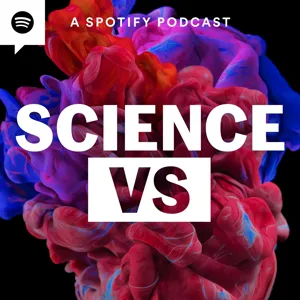Podcast Summary
The Fascinating History and Science of Chilli Peppers: Chilli peppers, with their fiery nature, are loved for the rush of endorphins they trigger and their rich history of global spread facilitated by trade and exploration.
The love for chilli peppers, despite their fiery nature, can be explained by their rich history and scientific properties. In this episode of Gastropod, hosts Nicola Twilley and Cynthia Graber delve into the world of chilli peppers, exploring their origins, how they spread across the globe, and why they've become a staple in various cuisines. They spoke with Maricel Presilla, a food scientist and author, who explained that the heat in chilli peppers comes from capsaicin, a compound that triggers a rush of endorphins, creating a feeling of pleasure and euphoria. The hosts also discussed how the spread of chilli peppers was facilitated by trade and exploration, and how they have evolved into the superhot varieties we know today. So, the next time you reach for a hot sauce or spicy dish, remember the fascinating history and science behind your love for chilli peppers.
Chili Peppers' Evolution and Early Human Discovery: Chili peppers evolved capsaicin to protect seeds, birds spread seeds, humans discovered peppers for insect-repelling and preservative properties
Chili peppers, which have South American origins, evolved the defensive compound capsaicin to protect their seeds from being consumed by most animals. Birds, however, were able to consume and pass the seeds through their digestive system, allowing for new plants to grow. Chili peppers contain the highest concentration of capsaicin in their placenta, the supporting tissue for the developing embryo. Early humans in South America may have discovered and consumed chili peppers due to their insect-repelling and fungus-fighting properties, which would have made the peppers a valuable addition to their limited diets and helped preserve other foods. Chili peppers' spiciness, which some believe is a defense mechanism to deter mammals from consuming them, may have actually attracted early humans to these plants due to their preservative qualities.
Ancient civilizations consumed spicy peppers for flavor and digestion: Ancient cultures used spicy peppers for taste enhancement and digestive aid, leading to the domestication of five pepper species including capsicum annuum
The use of spicy peppers dates back thousands of years, as evidenced by ancient poop samples found in Peru. These early civilizations, such as the El Brujo people, consumed various types of spicy peppers, likely for their enhanced flavors and aiding in digestion. Over time, five domesticated chili pepper species emerged, each with distinct heat profiles and flavor notes. The most common and diverse of these is capsicum annuum, which includes jalapenos, poblanos, and bell peppers. The discovery of these ancient pepper remains provides insight into the long history and cultural significance of this versatile and exciting food.
Plants Use Capsaicin as a Defense Mechanism: Capsaicin, the compound that makes chili peppers spicy, is a plant defense mechanism that triggers cooling responses and pain signals in humans, promoting evaporative cooling in tropical environments, and can be used as a weapon
Capsaicin, the compound that makes chili peppers spicy, is not just a flavor enhancer but a defense mechanism designed by plants to deter animals from consuming them. The sensation of heat from capsaicin is our body's response to a noxious stimulus, triggering various cooling mechanisms and pain signals. Capsaicin can be felt anywhere on the body, but its effects are most pronounced on the sensitive mucous membranes in the mouth and nose. Eating spicy foods can cause sweating, flushing, and increased heart rate, mimicking the body's response to a burn. These responses are evolutionarily useful in tropical environments, where spicy foods can help promote cooling through evaporative sweat. However, capsaicin can also be used as a weapon, with historical examples ranging from pepper spray to chili grenades. Today, scientists continue to explore the potential uses of capsaicin in various fields, from pain relief to food preservation.
Relief methods for chili pepper burn: Consume fatty and dairy products or cold water temporarily relieves chili pepper burn. Beer might provide relief due to cortical effect or anxiety reduction. Once capsaicin binds to receptors, it's hard to remove. Sensitivity varies from person to person.
When dealing with the burn of chili peppers, there are some methods that can provide temporary relief. The most effective way is to consume fatty and dairy products, as capsaicin is soluble in oil and milk contains a protein that can break the chemical bonds of free-floating capsaicin. Cold water can also offer some relief by counteracting the sensation of heat, but it won't help for long as capsaicin isn't water-soluble. Beer, which is often consumed with spicy dishes, may provide relief due to a cortical effect or anxiety reduction rather than directly quenching the burn. It's important to note that once capsaicin has bound to the receptors in your mouth, there's not much you can do to get it back out. So, suffering through the burn is inevitable to some extent. Additionally, the sensitivity to capsaicin varies from person to person, and some people may have fewer receptors triggered by it due to genetics or training their palate to handle heat.
Tasting Chili Peppers: Order Matters: The order in which we taste chili peppers can impact our perception of their heat levels. Cultural exposure and historical context also influence our appreciation and use of different spices.
The order in which we tried different chili peppers, starting with a mild one and moving on to progressively spicier ones, affected our perception of their heat levels. The speaker was unable to fully appreciate the spiciness of the Wiri Wiri pepper from Guyana due to desensitization from previous tastings. Aji amarillo, a Peruvian pepper, was described as a favorite due to its rounded, warm, and dissipating heat. The history of chili peppers was traced back to Columbus's discovery in the Caribbean, and their rapid spread and popularity in Europe due to their availability and affordability compared to expensive peppercorns. The speaker expressed respect for the Guyanese children who consume Wiri Wiri peppers as a staple. The discussion highlighted the impact of cultural exposure and historical context on the appreciation and use of different spices.
Impact of Chili Peppers on History and Culture: Chili peppers, with their adaptability and profound taste, have shaped various cuisines and cultures, contributing to global food systems and embodying symbolic significance in different regions.
Chili peppers have had a profound impact on various cuisines and cultures throughout history, particularly in regions where people were poor and lacked access to resources like salt. The peppers' adaptability, taste, and symbolic significance contributed to their widespread adoption and integration into different culinary traditions. For instance, in China, chilies were initially used to add flavor to bland grain-based diets and later became deeply entrenched in Chinese identity, embodying qualities like courage and masculinity. The Portuguese played a significant role in spreading chilies around the world, introducing them to countries like India, Bhutan, and Korea. Chilies' popularity can also be attributed to their versatility, as they grow well in various environments and add color and excitement to dishes. Overall, the story of chili peppers highlights the interconnectedness of global food systems and the ways in which simple ingredients can shape cultural identities.
The trend of spicy food popularity: Spicy food's popularity grew through migration and cultural exchange, leading to increased consumption and production in regions with milder cuisines. People now enjoy the pain and excitement of spicy food, and this trend is likely to continue.
The popularity of spicy food, particularly chili peppers, has spread widely across China and other parts of the world due to mass migration and cultural exchange. This trend started decades ago, and it has led to an increase in the consumption and production of spicy food in regions that traditionally had milder cuisines. The same thing happened in the US, where the preference for bland food gave way to a growing interest in hot sauces and salsa. The development of the Scoville scale, which measures the heat level of chili peppers, reflects this trend and shows how much people's taste preferences have changed. Today, many people enjoy the pain and excitement that come with eating spicy food, and they seek out the hottest chilies to satisfy their cravings. This trend is likely to continue as more people discover the flavors and sensations of spicy food.
Measuring the Heat of Chili Peppers: The Scoville Scale vs. Direct Capsaicin Measurement: The Scoville scale, which measures chili pepper heat based on dilution, has limitations due to capsaicin desensitization. Direct capsaicin measurement is becoming the preferred method. Superhot peppers, with their intense capsaicin sensation, continue to be a competitive breeding focus.
The Scoville scale, which measures the heat level of chili peppers, is an arbitrary system with limitations. Capsaicin, the compound responsible for the heat, can cause desensitization, making it difficult to accurately measure heat levels. Superhot peppers, which contain more capsaicin, have become a competitive sport among breeders. People are drawn to the sensation of capsaicin, which can be compared to a roller coaster ride, triggering a post-danger euphoria. However, the Scoville scale is being replaced by measuring capsaicin levels directly. The hottest pepper ever recorded has a capsaicin level of 16 million Scoville heat units, but actual chili peppers are nowhere near that. Breeders continue to push the limits, creating hotter and hotter peppers for the sensation-seeking chilihead community.
Consuming Extremely Hot Peppers: Dangers and Discomfort: Consuming extremely hot peppers, like the Carolina Reaper, can cause severe damage to the throat and mouth, including tears in the esophagus, and intense pain and discomfort. Proceed with caution and heed warnings from experts.
Consuming extremely hot peppers, like the Carolina Reaper, can cause severe pain and damage to the throat and mouth. The individual who ate a large amount of ghost pepper puree in 2016 ended up with an inch-long tear in his esophagus due to the post-chili vomiting and irritation. The owners of a spice store warned against taking large amounts of these peppers, suggesting only tasting a tiny amount. Despite their warning, the speakers in the podcast attempted to taste the Carolina Reaper and both experienced intense pain and discomfort. The pain persisted for several minutes and left them questioning why such peppers exist. This experience serves as a reminder of the potential dangers and discomfort associated with consuming extremely hot peppers.






